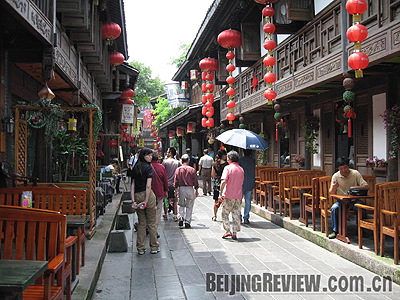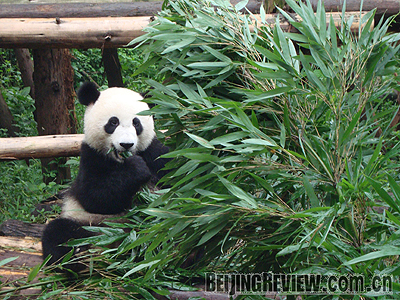|
 |
|
OPENING HOURS: Business as usual in the lanes of Chengdu City (JIANG WANDI) |
Upon visiting Chengdu, capital city of Sichuan Province, it is hard to imagine that just 73 km from the city so much destruction and suffering exist. This is not a city that seems at the edge of one of the world's worst natural disasters of recent times. Over two months have passed since the earthquake caused so much devastation to Sichuan, and on the surface life appears to continue as if nothing happened for the people of Chengdu City. The cicadas in the trees above the thriving tourist lanes hum as vibrantly as the energy of the city. The people here wish to move on. Of course there is much work to be done, but in their resilience to the challenges and tasks ahead, residents are adamant that the destroyed areas will be built better than before.
The earthquake has had an impact in many ways—fiscally, the tourism industry of Chengdu has been hit hard. The Tourism Bureau of the city believes this is partly due to peoples' fears of aftershocks, but also due to misunderstandings. The earthquake mainly affected the village areas to the west of the city. However, various international media sources misreported that Chengdu had experienced a catastrophic earthquake, when the actual truth was that very little structural damage affected the city itself, owing to the tectonic substructure under the plains around it.
 |
|
BEAR NECESSITIES: A bear eats out at the Research Base of Panda Breeding. Visitor numbers have dropped, but Chengdu survives (YUAN YUAN) |
Consequently, visitor figures have dropped. Hotel occupancy is reported to be 30 percent currently, compared to an average in the low season of between 50-60 percent and 80 percent in the high season. According to Guan Heyu, General Manager of the Chengdu Overseas Tourism Corp. Ltd., while his company made an estimated 6 million yuan ($857,000) in May compared to 30 million yuan ($4 million) in the same period last year, just 3 million yuan ($428,000) was procured in June.
Chengdu is a city that has flourished in popularity. It was awarded the title of Best Tourist City of China by the UN World Tourism Organization in 2007.
It's a city and surrounding area that is rich in sightseeing and cultural features, with highlights including the Chengdu Research Base of Giant Panda Breeding based 10 km from Chengdu proper, the home and gardens of the poet Du Fu (712-770), and traditional styled lanes (formerly a soldiers' garrison) representing aspects of the city's 3,000-year history. The city is also on the fringe of mountains of outstanding natural beauty and is a gateway for visitors to Tibet. It has succeeded in modern times with the traffic of life paying witness to its uniqueness.
Three of Chengdu's six administered county-level cities—Pengzhou, Chongzhou and Dujiangyan—were hit hardest by the earthquake, but are by no means off limits to travelers at the present time, as nearly all of the close lying scenic spots were undamaged. Indeed, Dujiangyan City has adopted free ticket policies to try to attract more people back to the area. Although some tourists are returning to the city, most are local people. A national advertising campaign is planned, aiming to lure more Chinese visitors.
|

